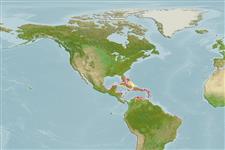Malacostraca |
Decapoda |
Callianassidae
Environment: milieu / climate zone / depth range / distribution range
Ecology
Benthic; depth range 0 - 2 m (Ref. 97531). Tropical
Western Atlantic: from Florida to Brazil.
Length at first maturity / Size / Weight / Age
Maturity: Lm ? range ? - ? cm Max length : 0.8 cm TL male/unsexed; (Ref. 87256)
Often buries down to a meter into vegetated (i.e., seagrass beds) and non-vegetated sediments (i.e., calcareous sand) on lower intertidal and subtidal sandy areas (Ref. 86837).
Life cycle and mating behavior
Maturity | Reproduction | Spawning | Eggs | Fecundity | Larvae
Members of the order Decapoda are mostly gonochoric. Mating behavior: Precopulatory courtship ritual is common (through olfactory and tactile cues); usually indirect sperm transfer.
Felder, D.L., P.C. Dworschak, R. Robles, H.D. Bracken, A.M. Windsor, J.M. Felder and R. Lemaitre 2009 Obvious invaders and overlooked infauna: Unexpected contituents of the decapod crustacean assemblage at Twin Cays, Belize. p. 181-188. In M.A. Lang, I.G. Macintyre, and K. Ruetzler (eds.) Proceedings of the Smithsonian Marine Science Symposium. Smithsonian Contributions to the Marine Sciences. Vol. 38. Washington, D.C.: Smithsonian Institution Scholarly Press. (Ref. 86837)
IUCN Red List Status
(Ref. 130435: Version 2025-1)
CITES status (Ref. 108899)
Not Evaluated
Not Evaluated
Threat to humans
Human uses
| FishSource |
Tools
More information
Population dynamicsGrowth
Max. ages / sizes
Length-weight rel.
Length-length rel.
Length-frequencies
Mass conversion
Abundance
Life cycleReproductionMaturityFecunditySpawningEggsEgg developmentLarvae PhysiologyOxygen consumption
Human RelatedStamps, coins, misc.
Internet sources
Estimates based on models
Preferred temperature
(Ref.
115969): 24.9 - 28.3, mean 27.3 (based on 336 cells).
Fishing Vulnerability
Low vulnerability (10 of 100).
Price category
Unknown.
